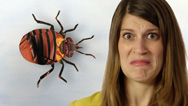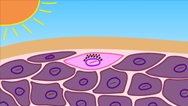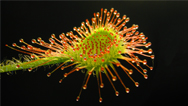What’s Lurking Inside Figs?
- By Anna Rothschild
- Posted 08.25.16
- NOVA
Figs are delicious—but they may contain the bodies of dead wasps. Learn more in this episode of Gross Science.
Transcript
What's Lurking Inside Figs?
Posted: August 25, 2016
Figs are one of my favorite foods. They're sweet and floral, and there's something about the texture that I find so delightful—the outside is soft, but the seeds in the middle give you this totally satisfying crunch. But it turns out that many species of figs contain the bodies of dead wasps.
I'm Anna and this is Gross Science.
Figs aren't exactly your typical fruit. You can think of them as packages that contain all of the fig tree’s flowers within them. But if the flowers are trapped inside the fig how do they get pollinated? Well, that's where fig wasps come in.
In most species, pregnant female fig wasps carrying pollen are attracted to young figs. They enter through a tiny opening at the fig’s bottom that’s highly selective—it usually only lets in the exact species of wasps that pollinate it. But, even the pollinators have a hard time getting in. Most lose their wings and antennae in the process.
The wasp’s goal is to find a home for her babies. And the perfect home is inside the fig’s female flowers—those are the ones that would produce seeds if they were fertilized. So, the mama wasp drops a fertilized egg inside as many of the female flowers as she can—sometimes, up to a few hundred. But she can't get to all of them. Along the way, she winds up fertilizing the rest of the flowers with the fig pollen she's carrying, and those flowers begin developing seeds. Once the wasp is finished laying eggs, she usually dies inside the fig.
Each baby wasp begins to grow, encased in a protective structure that the plant forms called a gall. The male wasps mature first. When they emerge, they find the galls of the female wasps, many of whom are their sisters, poke inside, and impregnate them before they've even hatched! Then, the males die inside the fig, but not before boring tiny holes through the fig’s skin.
When the females do emerge, the fig has just started producing pollen. The female wasps pick up some of that pollen before making their way through the holes their brothers drilled, and go off to find a new fig to start the cycle again.
But the story's not over. At this point, our fig’s seeds are finally mature and ready to be planted. And that happens when the ripe fig is eaten by animals, which poop out the seeds, spreading fig plants far and wide.
Of course, humans eat figs, too. So, when you bite into a fig are you actually eating the bodies of dead wasps? Well, if you’re getting your figs from the supermarket, then most likely not. See, humans and figs have a really long history—we’ve probably been domesticating them for over 11,000 years. So, while there are over 750 species in the world, most of the figs we eat are a species called the “common fig,” which humans have had a huge hand in creating. In fact, some common figs are seedless and don’t require pollination at all. Other varieties of common fig do need to be pollinated, but have separate male and female trees, and we only eat fruits from the female ones. I’ll put a link in the description to a great explanation of how common fig pollination happens, but long story short, female wasps can only manage to lay eggs in the the figs from male trees, not female ones. But they can’t tell the difference between the two types of trees. So, if a wasp does enter a female fruit, she’ll pollinate it, and either manage to escape or die inside the fig. And then that fig might make it to your table.
Frankly, one wasp here and there isn’t enough to deter me from eating these things. But if you're still feeling squeamish, just think about it this way: by eating that fig, you're benefitting from a complex and in my view, beautiful partnership—or, what’s called a “mutualism”— between two very different species. One that’s been delicately crafted by around 90 million years of evolution. And that certainly whets my appetite—at least for curiosity, if not for dinner.
MMMM! But also ew.
Credits
PRODUCTION CREDITS
- Host, Writer, Animator, Editor
- Anna Rothschild
- Camera, Production Help
- Julia Davis
- Illustration of Fig Cross-Section
- Eliza Lehner
- Chasing Tails
- Music Provided by APM
- Special thanks to Dr. Allen Herre
FOOTAGE AND IMAGES
- Original Footage
- ©WGBH Educational Foundation 2016
- Fig Wasps
- Gregory Dimijian/Science Photo Library
- Ceratosolen capensis op Ficus sur, Jan Celliers Park, a
- Wikimedia Commons/JMK
- 2004-03-27-Chimpanzee-eatin
- Wikimedia Commons/Drrobert
- Great hornbill eating fig
- Wikimedia Commons/Lip kee
- Lineated Barbet- Eating Goolar fig (Ficus racemosa)-Kolkata IMG 5810
- Wikimedia Commons/J.M.Garg
- Vervet Monkey (Chlorocebus pygerythrus) eaeting figs (17277655481)
- Wikimedia Commons/Bernard DUPONT
- LA FRUTERA (SNYDERS)
- Wikimedia Commons/Frans Snyders
- Common fig - Ficus carica - Incir 2
- Wikimedia Commons/Zeynel Cebeci
- Mercury fig leaf
- Wikimedia Commons/Sputnikcccp
- Jerusalem Machne Yehuda Market (8118463247)
- Wikimedia Commons/StateofIsrael
- Ficus carica 1.1R
- Wikimedia Commons/Rob Hille
SFX
- Cockroaches
-
Freesound/StateAardvark
(used with permission from author) - Squeak Pack/squeak_10
- Freesound/Corsica_S
- Flying Mosquito
- Freesound/zywx
- Bubbles Popping
- Freesound/ch0cchi
- Jelly Mangling On Plate
- Freesound/lolamadeus
- Produced by WGBH for PBS Digital Studios
POSTER IMAGE
- Feige-Schnitt
- Wikimedia Commons/Rainer Zenz
Sources
Want more info?
Great 1977 paper by J. Galil on Fig Biology:
http://bit.ly/2bxzKwa
More on the type of pollination that happens in common
figs:
http://bit.ly/2bxBaqc
Related Links
-

Gross Science
Bizarre stories from the slimy, smelly, creepy world of science.
-

What Really Causes Sunburns?
The way the sun damage your skin is weirder than you ever thought.
-

Four Deadly Carnivorous Plants
Here are four ingenious ways carnivorous plants catch their prey.
-

Sea Turtles Get Herpes, Too
Sea turtles can get herpes. And human pollution might be making their flare-ups worse.

